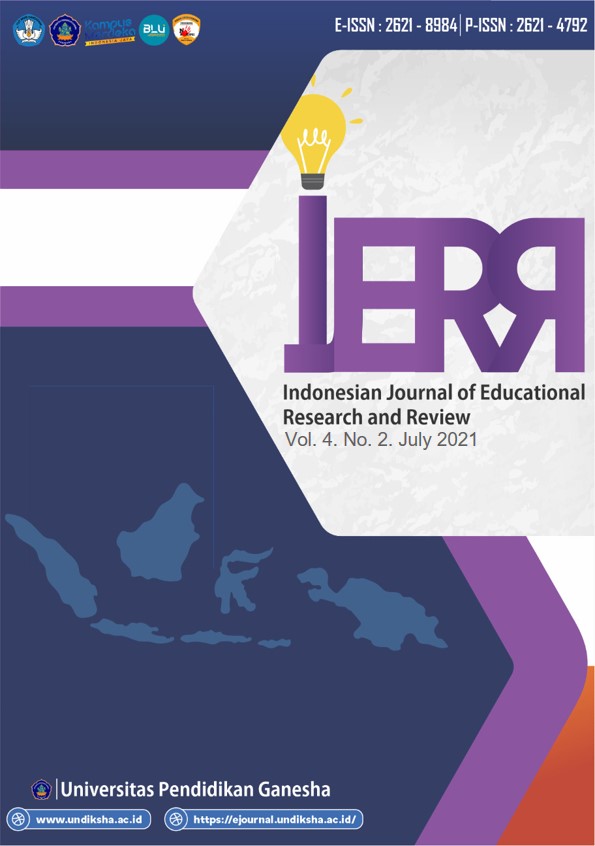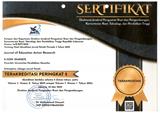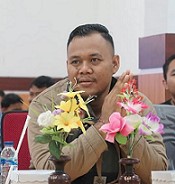Contextual Approach Animated Video in Science Material for Grade Fourth Elementary School Students
DOI:
https://doi.org/10.23887/ijerr.v4i2.39431Kata Kunci:
Pengembangan, Video, Animasi, KontekstualAbstrak
Lack of learning support materials and the need for media development to assist teachers in explaining learning materials. Learning is only based on the theme book. Therefore, it is necessary to develop animated videos with a contextual approach to the content of science material. This study aims to develop an animated video learning media with a contextual approach to the content of science material. This type of research is the development of the ADDIE model development research model. Data collection methods used are questionnaires or questionnaires, interview methods, and document recording methods. Data analysis techniques used are qualitative analysis techniques and quantitative analysis techniques. The subject of this research is the development of animated video media. The results of this study are a description of the design and development of animated video media with a contextual approach in the form of product development documentation and validation according to subject content experts' reviews which obtained a score of 100% very good qualification, a review of learning design experts obtained a score of 97% with very good qualifications. Learning media expert reviews obtained a score of 97% with very good qualifications, and media expert reviews were obtained by 97.3% with very good qualifications and group expert reviews with 98.67% gains with very good qualifications. So it can be said as the development of animated video media with a contextual approach is very well used in fourth-grade science material in elementary schools. The research implication is that contextual approach animation video media can help students in learning.
Referensi
Abendroth, J., & Richter, T. (2021). How to understand what you don’t believe: Metacognitive training prevents belief-biases in multiple text comprehension. Learning and Instruction, 71(August 2020), 101394. https://doi.org/10.1016/j.learninstruc.2020.101394
Agung, A. A. (2014). Buku Ajar Metodelogi Penelitian Pendidikan. Aditya Media Publishing.
Almas, I., & Krismayani, I. (2019). Kaji Tindak Penggunaan Meme Dalam Kegiatan Promosi Koleksi Ebook Di Perpustakaan Sma Negeri 3 Semarang. Jurnal Ilmu Perpustakaan, 6(3), 441–450. https://ejournal3.undip.ac.id/index.php/jip/article/view/23176/21201
Alnajdi, S. M. (2018). The Effectiveness of Designing and Using a Practical Interactive Lesson based on ADDIE Model to Enhance Students’ Learning Performances in University of Tabuk. Journal of Education and Learning, 7(6), 212. https://doi.org/10.5539/jel.v7n6p212
Amali, L. N., Zees, N., & Suhada, S. (2020). Motion Graphic Animation Video As Alternative Learning Media. Jambura Journal of Informatics, 2(1). https://doi.org/10.37905/jji.v2i1.4640
Andini, S., Budiyono, & Fitriana, L. (2018). Developing flipbook multimedia: The achievement of informal deductive thinking level. Journal on Mathematics Education, 9(2), 227–238. https://doi.org/10.22342/jme.9.2.5396.227-238
Audie, N. (2019). Peran Media Pembelajaran Meningkatkan Hasil Belajar Peserta Didik. Prosiding Seminar Nasional Pendidikan FKIP, 2(1), 586–595. https://jurnal.untirta.ac.id/index.php/psnp/article/view/5665
Chou, P.-N. (2013). Students Perceptions Of Success In The Online Graduate-Level Classes: A Self-Directed Learning Perspective. Contemporary Issues in Education Research (CIER), 6(1), 115. https://doi.org/10.19030/cier.v6i1.7610
Churri, M., & Agung, Y. (2013). Pengembangan Materi Dan Media Pembelajaran Mata Pelajaran Dasar Kompetensi Kejuruan Teknik Audio Video Untuk Smk Negeri 7 Surabaya. Jurnal Pendidikan Teknik Elektro, 2(2), 803–809. https://jurnalmahasiswa.unesa.ac.id/index.php/jurnal-pendidikan-teknik-elektro/article/view/4198
Fadhli, M. (2015). Pengembangan Media Pembelajaran Berbasis Video Kelas IV Sekolah Dasar. Jurnal Dimensi Pendidikan Dan Pembelajaran, 3(1), 24–29. https://doi.org/http://dx.doi.org/10.24269/dpp.v3i1.157
Febliza, A., & Okatariani, O. (2020). The Development of Online Learning Media by Using Moodle for General Chemistry Subject. Journal of Educational Science and Technology (EST), 6(1), 40. https://doi.org/10.26858/est.v6i1.12339
Goldschmidt, K. (2020). The COVID-19 Pandemic: Technology use to Support the Wellbeing of Children. Journal of Pediatric Nursing, 53, 88–90. https://doi.org/10.1016/j.pedn.2020.04.013
Gürsoy, G. (2021). Digital storytelling: Developing 21st century skills in science education. European Journal of Educational Research, 10(1), 97–113. https://doi.org/10.12973/EU-JER.10.1.97
Hamzah, I., & Mentari, S. (2017). Development of Accounting E-Module to Support the Scientific Approach of Students Grade X Vocational High School. Journal of Accounting and Business Education, 1(1), 78. https://doi.org/10.26675/jabe.v1i1.9751
Hidayatulloh, M. (2019). Developing Electrical Circuits Flipbook Using Flipbuilder. International Journal of Innovation Education and Research, 7(2), 124–134. https://doi.org/10.31686/ijier.vol7.iss2.1331
Hincal, E., & Alsaadi, S. H. (2021). Stability analysis of fractional order model on corona transmission dynamics. Chaos, Solitons & Fractals, 143, 110628. https://doi.org/10.1016/j.chaos.2020.110628
Irwansyah, F. S., Lubab, I., Farida, I., & Ramdhani, M. A. (2017). Designing Interactive Electronic Module in Chemistry Lessons. Journal of Physics: Conference Series, 895(1). https://doi.org/10.1088/1742-6596/895/1/012009
Ismara, K. I., Suharjono, A., & Supriadi, D. (2021). Ubiquitous learning in occupational health and safety for vocational education. International Journal of Evaluation and Research in Education, 10(1), 285–292. https://doi.org/10.11591/ijere.v10i1.20823
Jogezai, N. A., Baloch, F. A., Jaffar, M., Shah, T., Khilji, G. K., & Bashir, S. (2021). Teachers’ Attitudes Towards Social Media (SM) Use in Online Learning Amid The COVID-19 Pandemic: The Effects of SM Use by Teachers and Religious Scholars During Physical Distancing. Journal Heliyon, 7(4), 1–9. https://doi.org/10.1016/j.heliyon.2021.e06781
Kadafi, A., Alfaiz, A., Ramli, M., Asri, D. N., & Finayanti, J. (2021). The impact of islamic counseling intervention towards students’ mindfulness and anxiety during the covid-19 pandemic. Islamic Guidance and Counseling Journal, 4(1), 55–66. https://doi.org/10.25217/igcj.v4i1.1018
Kartika, Y., Wahyuni, R., Sinaga, B., & Rajagukguk, J. (2019). Improving Math Creative Thinking Ability by using Math Adventure Educational Game as an Interactive Media. Journal of Physics: Conference Series, 1179(1), 1–6. https://doi.org/10.1088/1742-6596/1179/1/012078
Kimianti, F., & Prasetyo, Z. K. (2019). Pengembangan E-Modul Ipa Berbasis Problem Based Learning Untuk Meningkatkan Literasi Sains Siswa. Kwangsan: Jurnal Teknologi Pendidikan, 7(2), 91. https://doi.org/10.31800/jtp.kw.v7n2.p91--103
Kolta, M. F., & Ghonimy, M. B. I. (2020). COVID-19 variant radiological findings with high lightening other coronavirus family (SARS and MERS) findings: radiological impact and findings spectrum of corona virus (COVID-19) with comparison to SARS and MERS. Egyptian Journal of Radiology and Nuclear Medicine, 51(1). https://doi.org/10.1186/s43055-020-00262-7
Komala, F. nur. (2016). Pembelajaran IPA Sekolah Dasar. Ediide Indografika.
Kühl, T. (2021). Prerequisite knowledge and time of testing in learning with animations and static pictures: Evidence for the expertise reversal effect. Learning and Instruction, 73. https://doi.org/10.1016/j.learninstruc.2021.101457
Latifa, I. S. (2017). The Analysis of Teachers’ Lesson Plan through Behavioral Objectives Theory. Advances in Social Science, Education and Humanities Research (ASSEHR), 82(1), 6–11. https://doi.org/10.2991/conaplin-16.2017.2
Lin, L., & Li, M. (2018). Optimizing learning from animation: Examining the impact of biofeedback. Learning and Instruction, 55. https://doi.org/10.1016/j.learninstruc.2018.02.005
Linda, Albeta, Masnaini, & Sulismawati. (2018). The Effect Of Prezy And Exe-Learning Media On Chemical Learning Results. Jurnal Edusains, 10(1). https://doi.org/10.15408/es.v10i1.7204.
Margareta, L., & Wahyuno, E. (2014). Penggunaan Media Animasi Macromedia Flash Untuk Meningkatkan Kualitas Pembelajaran Ipa Siswa Tunarungu Kelas II SDLB. Jurnal P3Lb, 1(2), 137–139. https://doi.org/10.17977/um029v1i22014p137-139
Marhayani, D. A. (2016). Development of Character Education Based on Local Wisdom in Indegenous People Tengahan Sedangagung. JETL (Journal Of Education, Teaching and Learning), 1(2), 66. https://doi.org/10.26737/jetl.v1i2.40
Maryanti, S., & Kurniawan, D. T. (2018). Pengembangan Media Pembelajaran Video Animasi Stop Motion Untuk Pembelajaran Biologi Dengan Aplikasi Picpac. Jurnal BIOEDUIN : Program Studi Pendidikan Biologi, 8(1), 26–33. https://doi.org/10.15575/bioeduin.v8i1.2922
Megawati, & Utami. (2020). English Learning with Powtoon Animation Video. Journal of Education Technology, 4(2), 110. https://doi.org/10.23887/jet.v4i2.25096
Mpungose, C. B. (2021). Lecturers’ reflections on use of Zoom video conferencing technology for e-learning at a South African university in the context of coronavirus. African Identities. https://doi.org/10.1080/14725843.2021.1902268
Mulyantini, N. L. D., Suranata, K., & Margunayasa, I. G. (2019). Pengaruh Model Pembelajaran Two Stay Two Stray Terhadap Minat Belajar Ipa Siswa Kelas IV SD. MIMBAR PGSD Undiksha, 7(1). https://doi.org/10.23887/jjpgsd.v7i1.17023
Mutakinati, L., Anwari, I., & Yoshisuke, K. (2018). Analysis of students’ critical thinking skill of middle school through stem education project-based learning. Jurnal Pendidikan IPA Indonesia, 7(1), 54–65. https://doi.org/10.15294/jpii.v7i1.10495
Noviyanto, T. S. H., Juanengsih, N., & Rosyidatun, E. S. (2015). Penggunaan Media Video Animasi Sistem Pernapasan Manusia Untuk Meningkatkan Hasil Belajar Biologi. Edusains, 7(1), 57–63. https://doi.org/10.15408/es.v7i1.1215
Nurtanto, M., Kholifah, N., Masek, A., Sudira, P., & Samsudin, A. (2021). Crucial problems in arranged the lesson plan of vocational teacher. International Journal of Evaluation and Research in Education (IJERE), 10(1), 345–354. https://doi.org/10.11591/ijere.v10i1.20604
Padli, F., & Rusdi. (2020). Respon Siswa dalam Pembelajaran Online Selama Pandemi. Social Landscape Journal, 1(3), 1–7. https://ojs.unm.ac.id/SLJ/article/view/14508
Patricia, A. (2020). College Students’ Use and Acceptance of Emergency Online Learning Due to COVID-19. International Journal of Educational Research Open, 1(1), 100011. https://doi.org/10.1016/j.ijedro.2020.100011
Putri, M. D., & Arifin, R. R. M. (2017). Pengaruh Penerapan Model Core Program Studi Pendidikan Guru Sekolah Dasar. Jurnal Khazanah Sekolah Dasar, 5(1), 111–123.
Rahayuningsih, S. (2020). Animation media of animal husbandry thematic science learning to stimulate scientific attitude in early childhood. International Journal of Scientific and Technology Research. https://doi.org/10.23887/jet.v3i1.17959 Article Metrics
Rigianti, H. A. (2020). Kendala Pembelajaran Daring Guru Sekolah Dasar Di Banjarnegara. Elementary School: Jurnal Pendidikan Dan Pembelajaran Ke-SD-An, 7(2). https://doi.org/10.31316/esjurnal.v7i2.768
Rozhana, K. M., & Harnanik, H. (2019). Lesson Study dengan Metode Discovery Learning dan Problem Based Instruction. Intelegensi: Jurnal Ilmu Pendidikan, 1(2). https://doi.org/10.33366/ilg.v1i2.1355
Rubini, B., Permanasari, A., & Yuningsih, W. (2018). Learning Multimedia Based on Science Literacy on the Lightning Theme. Jurnal Penelitian Dan Pembelajaran IPA, 4(2), 89–104. https://doi.org/10.30870/jppi.v4i2.3926
Sahu, P. (2020). Closure of Universities Due to Coronavirus Disease 2019 (COVID-19): Impact on Education and Mental Health of Students and Academic Staff. Cureus, 2019(4), 4–9. https://doi.org/10.7759/cureus.7541
Saripudin, E, Sari, I., & Mukhtar, M. (2018). Using Macro Flash Animation Media on Motion Material to Improve Learning Achievement for Learning Science in Junior High School. , 4 (1),. Journal of Science Research and Learning, 4(1), 68–75. https://doi.org/10.30870/jppi.v4i1.3316
Saripudin, Endang, Sari, I. J., & Mukhtar, M. (2018). Using Macro Flash Animation Media on Motion Material to Improve Learning Achievement for Learning Science in Junior High School. Jurnal Penelitian Dan Pembelajaran IPA, 4(1), 68–75. https://doi.org/10.30870/jppi.v4i1.3316
Sarnoko, S., Ruminiati, R., & Setyosari, P. (2016). Penerapan Pendekatan Savi Berbantuan Video Pembelajaran untuk Meningkatkan Aktivitas dan Hasil Belajar IPS Siswa Kelas IV Sdn I Sanan Girimarto Wonogiri. Jurnal Pendidikan: Teori, Penelitian, Dan Pengembangan, 1(7), 1235–1241. https://doi.org/10.17977/jp.v1i7.6524
Satyawan, V. (2018). The Use Of Animation Video To Teach English At Junior High School Students. Jellt (Journal of English Language and Language Teaching), 2(2), 89–96. https://doi.org/10.36597/jellt.v2i2.3277
Setiawan, Innatesari, D. K., Sabtiawan, W. B., & Sudarmin, S. (2017). The development of local wisdom-based natural science module to improve science literation of students. Jurnal Pendidikan IPA Indonesia, 6(1), 49–54. https://doi.org/10.15294/jpii.v6i1.9595
Shodiq, I. J., & Zainiyati, H. S. (2020). Pemanfaatan Media Pembelajaran E-Learning Menggunakan Whastsapp Sebagai Solusi Ditengah Penyebaran Covid-19 Di Mi Nurulhuda Jelu. Al-Insyiroh: Jurnal Studi Keislaman, 6(2), 144–159. https://doi.org/10.35309/alinsyiroh.v6i2.3946
Suartama, I. K. (2016). Materi 4 Evaluasi dan Kriteria Kualitas Multimedia Pembeajaran Oleh : I Kadek Suartama Jurusan Teknologi Pendidikan Universitas Pendidikan Ganesha Tahun 2016. September, 1–18.
Tapingkae, P., Panjaburee, P., Hwang, G.-J., & Srisawasdi, N. (2020). Effects of a formative assessment-based contextual gaming approach on students’ digital citizenship behaviours, learning motivations, and perceptions. Computers & Education, 159. https://doi.org/10.1016/j.compedu.2020.103998
Trianawati. (2019). Pengaruh Model Discovery Learning Berbantuan Media Animasi Terhadap Kompetensi Pengetahuan IPA Siswa Kelas IV SDN Gugus VI Abiansemal Tahun Ajaran 2018/2019. International Journal of Elementary Education, 4. https://doi.org/10.23887/ijee.v4i1.24337
Van Alten, D. C. D., Phielix, C., Janssen, J., & Kester, L. (2020). Self-regulated learning support in flipped learning videos enhances learning outcomes. Computers and Education, 158(August), 104000. https://doi.org/10.1016/j.compedu.2020.104000
Widiyasanti, M., Proketen, S. D., & Yogyakarta, N. (2018). Pengembangan Media Video Animasi Untuk Meningkatkan Motivasi Belajar Dan Karakter Tanggung Jawab Siswa Kelas V. Jurnal Pendidikan Karakter, 8(1), 1–16. https://doi.org/10.21831/jpk.v8i1.21489
Wiyani, N. A. (2013). Desain Pembelajaran Pendidikan. Ar-ruz Media.
Wu, T. T., & Wu, Y. T. (2020). Applying project-based learning and SCAMPER teaching strategies in engineering education to explore the influence of creativity on cognition, personal motivation, and personality traits. Thinking Skills and Creativity, 35(January), 100631. https://doi.org/10.1016/j.tsc.2020.100631
Yulando, S., Sutopo, S., & Franklin Chi, T. (2019). Electronic Module Design and Development: An Interactive Learning. American Journal of Educational Research, 7(10), 694–698. https://doi.org/10.12691/education-7-10-4
Yunitasari, R., & Hanifah, U. (2020). Pengaruh Pembelajaran Daring terhadap Minat Belajar Siswa pada Masa COVID 19. Edukatif : Jurnal Ilmu Pendidikan, 2(3), 232–243. https://doi.org/10.31004/edukatif.v2i3.142
Unduhan
Diterbitkan
Cara Mengutip
Terbitan
Bagian
Lisensi
Authors who publish with the Indonesian Journal of Educational Research and Review (IJERR) agree to the following terms:
- Authors retain copyright and grant the journal the right of first publication with the work simultaneously licensed under a Creative Commons Attribution License (CC BY-SA 4.0) that allows others to share the work with an acknowledgment of the work's authorship and initial publication in this journal.
- Authors are able to enter into separate, additional contractual arrangements for the non-exclusive distribution of the journal's published version of the work (e.g., post it to an institutional repository or publish it in a book), with an acknowledgment of its initial publication in this journal.
- Authors are permitted and encouraged to post their work online (e.g., in institutional repositories or on their website) prior to and during the submission process, as it can lead to productive exchanges, as well as earlier and greater citation of published work. (See The Effect of Open Access)












